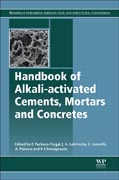
Handbook of Alkali-Activated Cements, Mortars and Concretes
Pacheco-Torgal, Fernando
Labrincha, João
Leonelli, C
Palomo Fernández, Gema
Chindaprasit, P
This book provides an updated state-of-the-art review on new developments in alkali-activation. The main binder of concrete, Portland cement, represents almost 80% of the total CO2 emissions of concrete which are about 6 to 7% of the Planet's total CO2 emissions. This is particularly serious in the current context of climate change and it could get even worse because the demand for Portland cement is expected to increase by almost 200% by 2050 from 2010 levels, reaching 6000 million tons/year. Alkali-activated binders represent an alternative to Portland cement having higher durability and a lower CO2 footprint. Reviews the chemistry, mix design, manufacture and properties of alkali-activated cement-based concrete bindersConsiders performance in adverse environmental conditions.Offers equal emphasis on the science behind the technology and its use in civil engineering. INDICE: 1 Introduction to the Handbook of Alkali-activated Cements, Mortars and Concretes Part I. Chemistry, mix design and manufacture of alkali-activated, cement-based concrete binders 2 An overview of the chemistry of alkali-activated cement-based binders 3 Crucial insights on the mix design of alkali-activated cement-based binders. 4 Reuse of urban and industrial waste glass as a novel activator for alkali-activated slag cement pastes: A case study Part II. The Properties of Alkali-activated Cement, Mortar and Concrete Binders 5 Setting, segregation and bleeding of alkali-activated cement, mortar and concrete binders 6 Rheology parameters of alkali-activated geopolymeric concrete binders 7 Mechanical strength and Young's modulus of alkali-activated cement-based binders 8 Prediction of the compressive strength of alkali-activated geopolymeric concrete binders by neuro-fuzzy modelling: A case study 9 Analysing the relation between pore structure and permeability of alkali-activated concrete binders 10 Assessing the shrinkage and creep of alkali-activated concrete binders Part III. Durability of Alkali-activated Cement-based Concrete Binders 11 The frost resistance of alkali-activated cement-based binders 12 The resistance of alkali-activated cement-based binders to carbonation 13 The corrosion behaviour of reinforced steel embedded in alkali-activated mortar 14 The resistance of alkali-activated cement-based binders to chemical attack 15 Resistance to alkali-aggregate reaction (AAR) of alkali-activated cement-based binders 16 The fire resistance of alkali-activated cement-based concrete binders 17 Methods to control efflorescence in alkali-activated cement-based materials Part IV. Applications of Alkali-activated Cement-based Concrete binders 18 Reuse of aluminosilicate industrial waste materials in the production of alkali-activated concrete binders 19 Reuse of recycled aggregate in the production of alkali-activated concrete 20 Using alkali-activated concrete binders for toxic waste immobilization 21 The development of alkali-activated mixtures for soil stabilisation 22 Alkali-activated cements for protective coating of OPC concrete 23 The performance of alkali-activated mortars for the repair and strengthening of OPC concrete 24 The properties and durability of alkali-activated masonry units Part V. LCA and Innovative Applications of Alkali-activated Cements and Concretes 25 Life cycle analysis (LCA) of alkali-activated cements and concretes 26 Alkali-activated concrete binders as inorganic thermal insulator materials 27 Alkali-activated cements for photocatalytic degradation of organic dyes 28 Innovative applications of inorganic polymers (geopolymers)
- ISBN: 978-1-78242-276-1
- Editorial: Woodhead Publishing
- Encuadernacion: Cartoné
- Páginas: 858
- Fecha Publicación: 15/12/2014
- Nº Volúmenes: 1
- Idioma: Inglés
